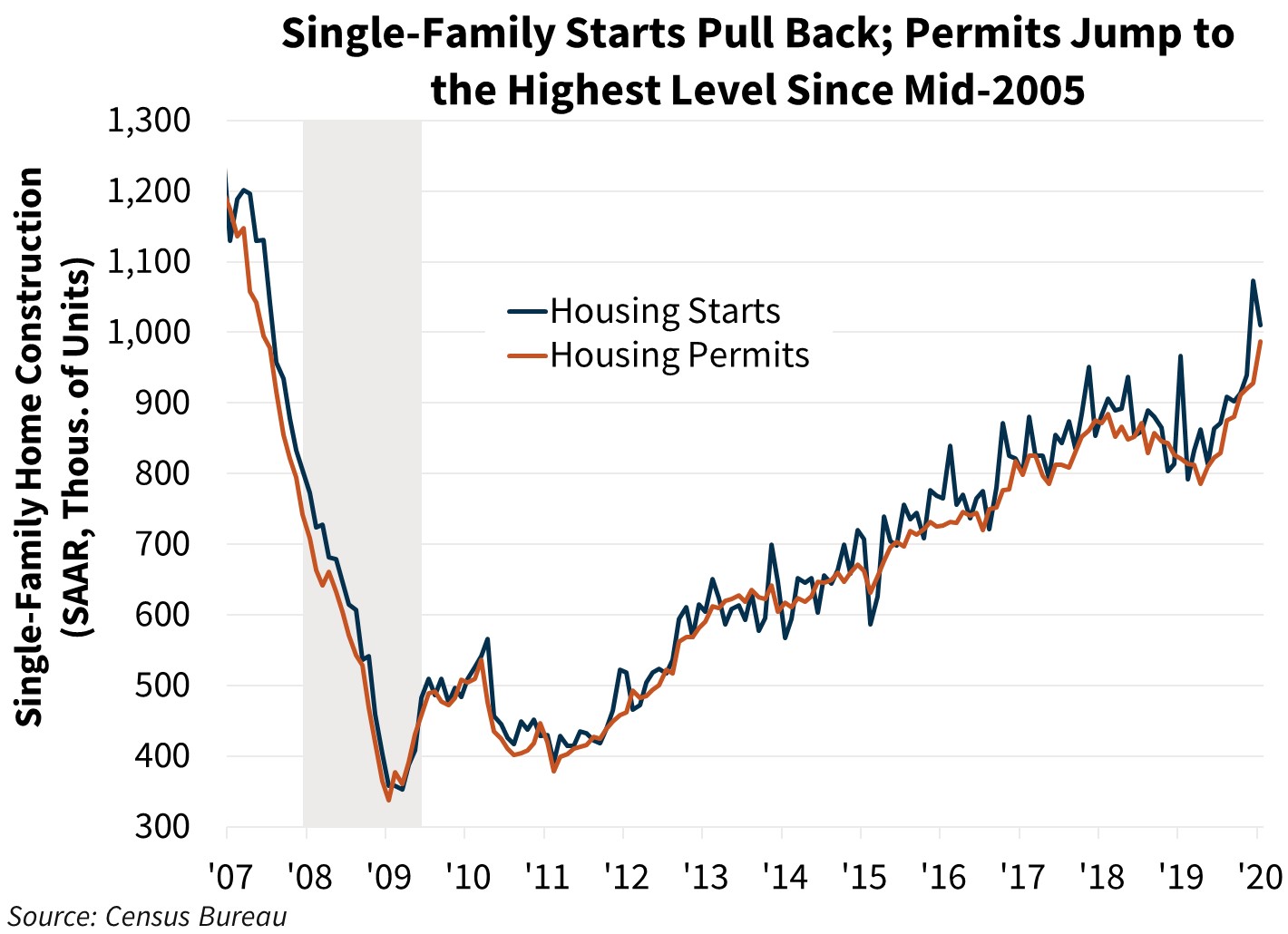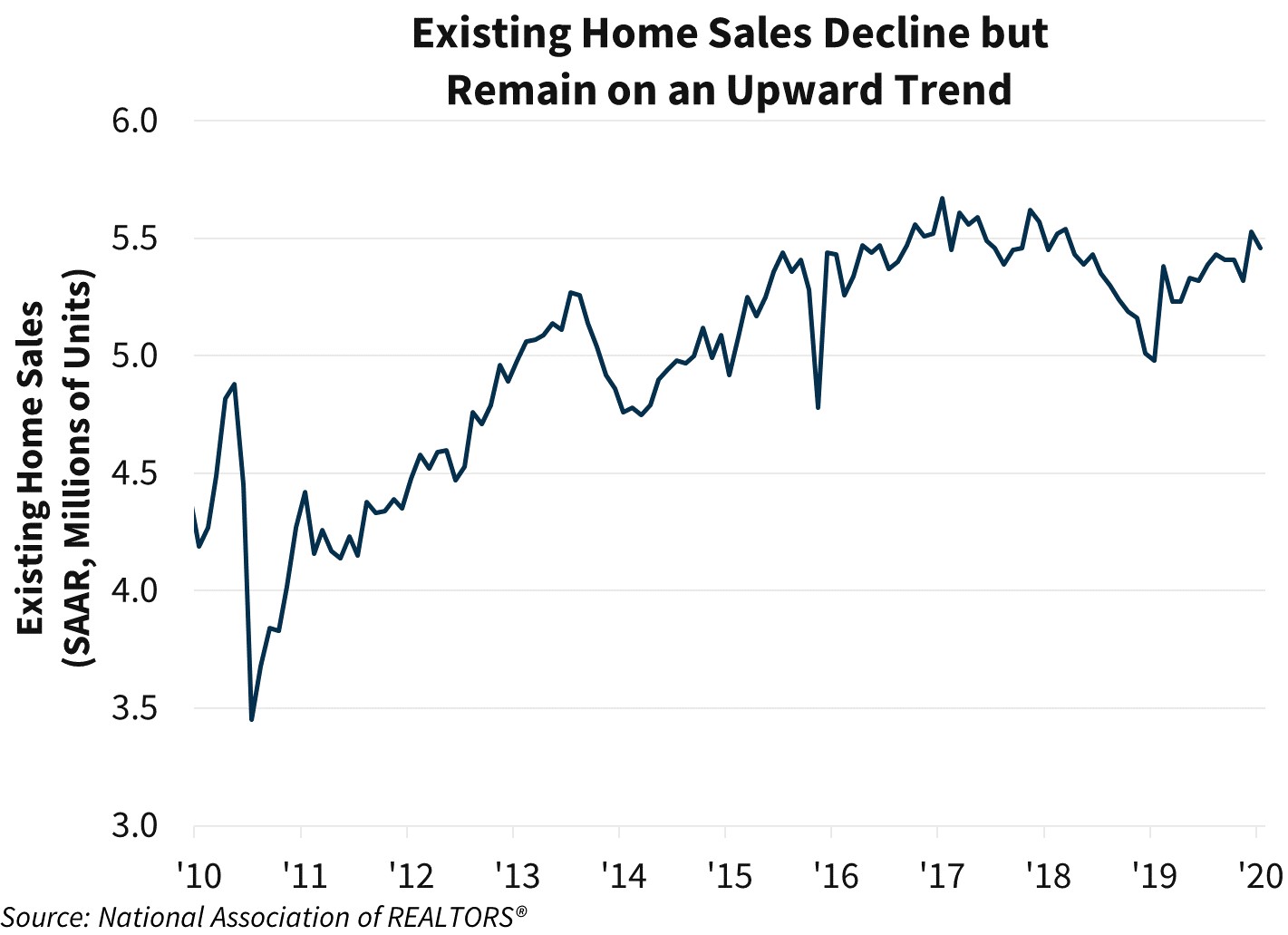Housing Starts and Existing Home Sales Pull Back Less Than Expected
Key Takeaways:
- Housing starts pulled back 3.6 percent in January, according to the Census Bureau. Single-family starts fell 5.9 percent but remained above one million annualized units for the second straight month. Single-family permits jumped to 987,000 annualized units, the highest level since June 2007.
- Existing home sales fell 1.3 percent in January to a seasonally adjusted annualized rate (SAAR) of 5.46 million. While declining mortgage rates should support home sales, inventories remain tight. The months’ supply for existing homes was only 3.1 months and for-sale inventories fell on a year-over-year basis by 10.7 percent, the eighth consecutive month of declines and the largest since the end of 2017.
- The FOMC minutes from its January meeting showed that the committee was comfortable with its policy stance and the economy given a strong labor market and the robust household sector. However, the committee noted it is monitoring continually weak inflation and global risks, such as the coronavirus outbreak in China.
- The Conference Board Leading Economic Index® (LEI) rose 0.8 percent in January, driven by increases in eight out of the ten indicators. Particular strength came from weekly unemployment claims, building permits, stock prices, and consumer expectations for business conditions. The LEI’s six-month growth rate returned to positive territory for the first time in four months.
Forecast Impact
After strong increases at the end of 2019, both housing starts and existing home sales fell in January as expected, though not by the magnitude we forecasted. For housing starts, this may have been a result of the abnormally warm January weather. Single-family permits were stronger than expected to start the year, suggesting greater strength in single-family housing starts over the next few months. Inventories of existing homes remained very tight in January, though strength in the labor market and persistently low interest rates should help keep demand robust. The FOMC minutes highlighted the strength of the macroeconomy, and despite its mention of persistently low inflation and global risks we maintain that the Fed will hold interest rates steady for the remainder of the year.


Details on Key Takeaways and Other Releases
- Housing starts fell in January to 1.57 million annualized units, according to the Census Bureau. Despite the decline, housing starts remained at the second highest level since December 2006. Single-family starts fell 5.9 percent to 1.01 million annualized units. Multifamily starts rose 0.7 percent to 557,000 annualized units, the highest level since December 1986. Single-family building permits jumped 6.4 percent, the largest monthly increase since September 2012, to 987,000 annualized units, the highest level since June 2007. Multifamily permits rebounded from December’s steep decline to 564,000 annualized units.
- Existing home sales fell 1.3 percent in January to a SAAR of 5.46 million, according to the National Association of REALTORS®. On an annual basis, existing sales rose 9.6 percent. Single-family sales dipped 1.2 percent to 4.85 million, though this was still the second highest level of sales since March 2018. Condo/co-op sales decreased 1.6 percent to a seasonally adjusted rate of 610,000 annualized units. Regionally, sales plummeted in the West, rose in the South and Midwest, and remained unchanged in the Northeast. The median sales price, which is not adjusted for the mix of sales, rose 6.8 percent year over year, a deceleration from the prior month.
- This week the Federal Open Market Committee (FOMC) released the minutes from its meeting on January 28-29, 2020, during which the committee decided to leave the federal funds rate unchanged at a range of 1.50 percent to 1.75 percent. Meeting participants “generally judged that the current stance of monetary policy was appropriate to support sustained expansion of economic activity,” citing a strong labor market and relative strength in the household sector. Participants also noted that both headline and core PCE inflation readings remain below 2 percent. While generally participants expected inflation to rise to 2 percent given further economic expansion and high resource utilization, a few participants expressed doubt regarding that outlook, hence the change in language in the post-meeting statement indicating that “policymakers were not satisfied with inflation outcomes that were persistently below 2 percent.”
- The Conference Board Leading Economic Index (LEI), a gauge of the economic outlook over the next three to six months, rose 0.8 percent in January to 112.1, reversing the decrease seen last month. The only negative contributor was the ISM New Orders Index. Average weekly manufacturing hours held steady in January.
Ricky Goyette
Economic and Strategic Research Group
February 21, 2020
Opinions, analyses, estimates, forecasts and other views of Fannie Mae's Economic and Strategic Research (ESR) Group included in these materials should not be construed as indicating Fannie Mae's business prospects or expected results, are based on a number of assumptions, and are subject to change without notice. How this information affects Fannie Mae will depend on many factors. Although the ESR group bases its opinions, analyses, estimates, forecasts and other views on information it considers reliable, it does not guarantee that the information provided in these materials is accurate, current or suitable for any particular purpose. Changes in the assumptions or the information underlying these views could produce materially different results. The analyses, opinions, estimates, forecasts and other views published by the ESR group represent the views of that group as of the date indicated and do not necessarily represent the views of Fannie Mae or its management.
